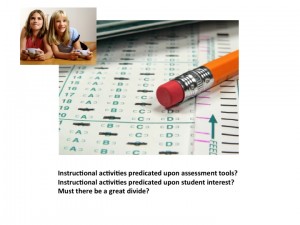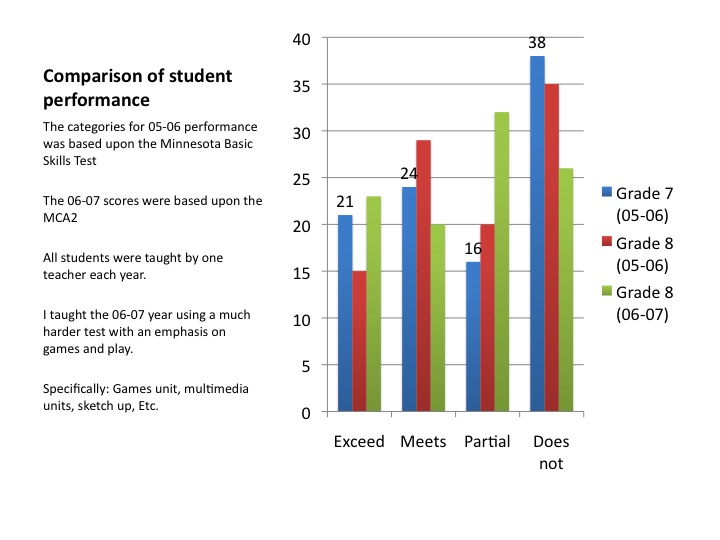Using Video Games to Improve Reading
Posted by PLB Registrar · 4 Comments

 The work Brock Dubbels has done surrounding games has led to improvement in reading scores. In this article he explains the successful approaches and strategies in using video games and play to tackle the achievement gap and improve scores in reading.
The work Brock Dubbels has done surrounding games has led to improvement in reading scores. In this article he explains the successful approaches and strategies in using video games and play to tackle the achievement gap and improve scores in reading.
“In 2006-2007, I took over the Language Arts Instruction for an entire middle school in Minneapolis, MN. The students were primarily drawn from North Minneapolis, qualified for free and reduced lunch, and were very bright, but were not scoring well on the standardized assessments. I implemented a curriculum that studied video games as new forms of narrative. Games tell stories, just like the anthologies stacked on my shelves. The difference was that when I pulled out the anthologies, classroom management became more challenging, as most of the kids were willing to get a behavioral referral than sit through reading “The Treasure of Lemon Brown” from the anthology.
These referrals were a lot of work, and there is no academic learning happening during that process.
I decided that instead of pushing stories at them, I should ask them what kind of media they liked. Most of them told me that they played video games and liked television, but few if any had any idea that there was anything of value in games besides entertainment. There was no hidden genius here–that somehow kids are digital natives and have great knowledge and critical thinking skills with video games and television, where they didn’t with printed text. The difficulty that I was facing came from a large percentage (38%) had a cutscore of 1 on the Minnesota Basic Skills Test (MBST)– a test based upon recall– and we were about to face the Minnesota Comprehension Assessment 2 (MCA2), which is a comprehension assessment based upon the standards for reading and literature. My kids were all bright, but they were not engaging, and they were not getting practice identifying the kind of conceptual development necessary to do well: they were not learning literary elements and genre patterns.
I was not sure whether this was because they couldn’t or wouldn’t.
So I decided to find out and created a curriculum of game study.
The organizing principle was that games are new forms of narrative, and that by studying game narratives, I could teach them literary elements and genre patterns. I created rubrics and assignments from the literary elements from the Minnesota state standards and integrated ideas from traditional Language Arts curriculum.
You will notice that between Seventh grade (Blue) and the Eighth grade the following year (Green) there was significant improvement in the school column. During that eighth grade year, I had all of the eighth -graders–but more importantly, we had a significant gain in a year when we switched from the Minnesota Basic Skills Test/ Minnesota Comprehension Assessment to the MCA2, which is a significantly harder test.
What you see in comparing my eighth-graders (GREEN) with the eighth-graders the year before (RED) was that there was a significant difference in achievement differences in the bottom performers (who are the hardest to move btw) –significantly fewer, a change of 9% in comparing eighth grade to eighth grade in “Does Not Meet”, and a 12% improvement between the 05-06 seventh-grade students, and their scores as eighth-graders.
The increase in students taking the test (they were all coming to class because of the curriculum!), and the amount of students who met or exceeded a higher standard was very satisfying, and I had fun teaching the unit, and the kids really valued the time we spent and professed learning. The unit was not easy, but the students had something interesting and more concrete to apply the concepts I want them to learn. Remember, I built my games unit on the standards and my background in reading comprehension made games an easy connection — games are another narrative with all the same literary elements and genre patterns. They were basically doing a technical writing assignment in the form of a multimedia book report.
The bottom line, they surpassed expectations on the more difficult MCA2 test. We were expected to go down 12%.
Key Factors:
- We did do complementary readings, like The Odyssey, Raisin in the Sun, Sonny’s Blues, Langston Hughes, and more.
- The key element was that the kids now had a portal into these other areas. Applying what we learned about game studies created practice for how to talk about literature.
- It also valorized activities kids choose outside of school, where kids who were often not high achievers, could lead with their prior knowledge and experience and channel that into developing academic skills.
- One of the key factors was helping the students visualize and create mental representation with the literary concepts, because they did not have to learn from a text, but saw actual images and could form them out of what Piaget called Image Schemas–mental representations from the senses, and learn the characteristics of the literary terms in the context of the things they were abstracted from.It is much easier to create a story board from a game by using screen shots, than having kids try to decide what printed text was saying and then make the story board. But that is often what we do in the classroom. Present the abstract concept, and ask them to learn in by reading–another abstract process dependent upon decoding and translating symbols into mental images. This seems backwards.Imagine a child who has never seen a peach, or known anything about peaches trying to decode, “he lifted the peach to his mouth and took a bite, and was surprised to be tickled on his lips and the roof of his mouth.”Without prior knowledge and experience, the child cannot know about peach fur. Might they imagine arms and tickling fingers?
Games and objects ground instruction, and provide the basis for experience and mental representation — comprehension. When we have this, we can spend less time decoding and more time discussing printed text. So by writing about accessible narratives such as games, we were more successful when reading related printed text. We had learned process, concepts, and deconstructing problems. This led to huge changes in student academic performance and confidence.
From Professional Learning Board’s online continuing education course for teachers: Videos in the Classroom.





Your work is amazing & outstanding. I enjoy the storylines of video games these days. Some have excellent social commentary or interesting insights into history. Also some are excellent examples for teaching geography. What games did you use?